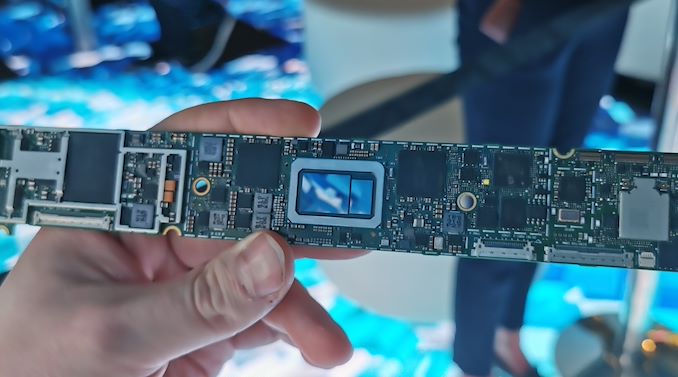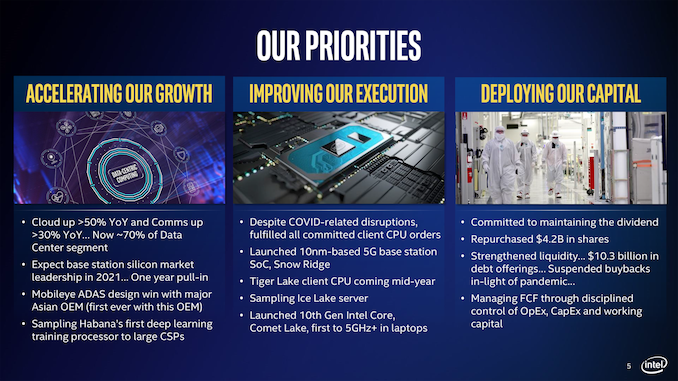Intel: Tiger Lake Client CPUs Coming Mid-Year
by Ryan Smith on April 24, 2020 10:00 AM EST
Along with detailing the nuts and the bolts of their Q1 2020 earnings, as part of Intel’s financial presentation, the company also offered a quick update on their upcoming Tiger Lake client CPUs. In short, the company is now preparing for volume production of the chips, and expects to being shipping them to OEMs mid-year.
Intel first unveiled Tiger Lake back at CES 2020 early this year, where the company briefly detailed the architecture while showing off a device using a prototype chip. Tiger Lake will be based on Intel’s latest Core CPU architecture, and will also be the first CPU from the company to integrate an iGPU based on their new Xe-LP graphics architecture. The chips will be based on a newer version of Intel’s 10nm manufacturing process than what’s used in the current ice Lake chips, which Intel is calling their 10+ process. At the time, Intel was promising that Tiger Lake devices would show up by the holidays, a similar time frame as 2019’s Ice Lake launch.
All told then, Intel’s most recent update is right in-line with their previous promises. With Tiger Lake being another mobile-first launch, OEMs need to receive chips well in advance of when consumer products will reach the store shelves, both to give OEMs the necessary time to finalize their designs, as well as to build up a suitable stockpile of devices for a proper retail launch. So, as it always needs to be said when talking about Intel’s timelines for manufacturing, while Tiger Lake chips will be shipping mid-year, we’re not currently expecting devices any sooner than what Intel has previously discussed.
Finally, if everything goes according to plan or Intel, it looks like the Tiger Lake launch should be a higher volume affair than Ice Lake’s. Cognizant of Ice Lake’s slow ramp-up and launch in 2019, Intel is telling investors that they are holding twice as many Tiger Lake CPUs in reserve as compared to Ice Lake. The company does need to master its updated 10+ process to get there, but with any luck, Intel’s 4+ years of playing with 10nm may finally pay some better dividends as they bring up their latest process.
#ontherun #TigerLake pic.twitter.com/Dhm1TwlcjV
— 𝐷𝑟. 𝐼𝑎𝑛 𝐶𝑢𝑡𝑟𝑒𝑠𝑠 (@IanCutress) January 8, 2020











140 Comments
View All Comments
yeeeeman - Saturday, April 25, 2020 - link
Yeah, I was sarcastic. I know it is a combination of many factors. I would add to what you said, bad management. They got used to great execution they even created the tick tock model. When 22nm ramped harder than previous nodes, they probably didn't adjust fab plans. 14nm was even worse but they still didn't learn their lesson because with 10nm they just went overboard with the features. any sane person would look at the past two nodes and say...let's learn something and do this one differently. Anyway...Spunjji - Monday, April 27, 2020 - link
100% with yeeeeman here. They let marketing set the roadmaps instead of engineering, and I get the impression there was an increasingly strong "yes culture" in middle-management that obfuscated the extent of the issues they were having in the foundry until it was too late, at which point they were deep into saving face at all costs.Yojimbo - Monday, April 27, 2020 - link
Could be, but I think we're in the realm of pure speculation here. For all we know it was the engineering team leaders saying "push, push, we can do this."Spunjji - Monday, April 27, 2020 - link
The narrative about management woes has been corroborated by several long serving ex-Intel engineers - so while the usual cautions about trusting anecdotal evidence from former employees come into play, it does sound (and look) a lot like there were serious issues at the middle-management level that were at least significant contributing factors to their current difficulties.name99 - Monday, April 27, 2020 - link
For anyone who wants to collaborate this compare:https://www.thelayoff.com/intel
https://www.thelayoff.com/apple
The Intel complaints are pretty much all about how their managers suck.
The Apple complaints (ever since Apple picked up the modem division) are ALSO pretty much all about how the Intel managers suck!
Spunjji - Tuesday, April 28, 2020 - link
lol. Says it all, really.I did get a kick out of Apple buying their junk modem division. Apple will be taking revenge for that one soon enough when they kick Intel out of their low-end laptops.
Deicidium369 - Saturday, April 25, 2020 - link
All comes down to trying to make Gen 1 of 10nm 2.7X density increase instead of 2x. 10nm+ reaches that 2.7x density target. I also think that Cobalt was a lot more challenging - something that neither Samsung or TSMC has started on. So this time was used to benefit long term. Besides they could not make enough 14nm to fill all the orders, so 10nm would have been cool several years ago, but from a business point of view - un needed.Depends on the other business units being expanded - 5G was sold to Apple, their Networking unit is very strong (even selling on most AMD systems) as are the Optane unit. So dilution is not much of an issue - this all plays into the taking control of more of the TAM for silicon.
Spunjji - Monday, April 27, 2020 - link
"Besides they could not make enough 14nm to fill all the orders, so 10nm would have been cool several years ago, but from a business point of view - un needed."How would having additional manufacturing capacity from a newer node - and being able to continue out-competing their closest rival on both transistor density and CPU core design - ever have been "un-needed"? 🤨
Deicidium369 - Monday, May 4, 2020 - link
I know in the AMD world lithography is some magical panacea - but it's not.You miss the point like a short outfielder misses a pop fly. Business only cares about revenues - and of your older much more optimized platform is selling in volumes you cannot keep up with - adding another newer products on the new process - would make little sense.]
From an enthusiast point of view - I would say that it WAS needed...
mode_13h - Saturday, April 25, 2020 - link
Intel's pretty notorious for making repeated and painful job cuts.I don't have the data to back this up, but I think you should try to compare that R&D spend to a basket of companies that cover the equivalent business activities and markets to where Intel plays. I don't think your picture would look so rosy, then.
My sense is that each new manufacturing node is significantly more expensive than the last. And here's where Intel probably fell down. Why don't you plot TSMC's R&D spend, over the same time? If you can get Samsung's semiconductor manufacturing R&D, put that up too.
I never said that dividends were corruption, but I think you really can't argue that it's actually *good* for operations to do it, regardless of whether a company is executing to plan. When a company is having problems with execution, maybe the root cause isn't money, but often some extra spend can still help them get through a rough patch.